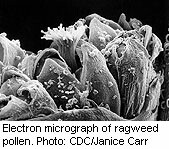
FRIDAY, Nov. 9 (HealthDay News) — Many people believe that this was the worst year for hay fever, but seasonal allergies will get worse as pollen counts more than double over the next 28 years, a new study predicts.
Pollen counts, which averaged 8,455 in 2000, are expected to reach 21,735 by 2040, according to the research presented Friday at the annual meeting of the American College of Allergy, Asthma and Immunology (ACAAI) in Anaheim, Calif.
As pollen counts rise, the sneezing season will begin earlier each year, the study authors said. “In 2000, annual pollen production began on April 14 and peaked on May 1,” study author and allergist Dr. Leonard Bielory said in an ACAAI news release.
In 2040, pollen levels are predicted to peak on April 8, according to the ongoing study, conducted at Rutgers University in New Brunswick, N.J.
“Climate changes will increase pollen production considerably in the near future in different parts of the country,” Bielory added.
“Economic growth, global environment sustainability, temperature and human-induced changes, such as increased levels of carbon dioxide, are all responsible for the influx that will continue to be seen,” he explained.
In an earlier study, the same researchers found that ragweed pollen levels in a section of the United States from Texas to the Canadian border increased over the past 25 years.
During allergy season, people with hay fever should monitor pollen and mold counts, keep windows and doors shut at home, and keep car windows closed, the ACAAI suggests. Allergy sufferers should stay inside during mid-day and afternoon hours when pollen counts are highest, wear a mask when outdoors doing chores such as mowing the lawn, and take a shower, wash their hair and change their clothes after working or playing outdoors.
The data and conclusions of research presented at meetings should be considered preliminary until published in a peer-reviewed medical journal.
More information
The U.S. National Institute of Environmental Health Sciences has more about pollen.

